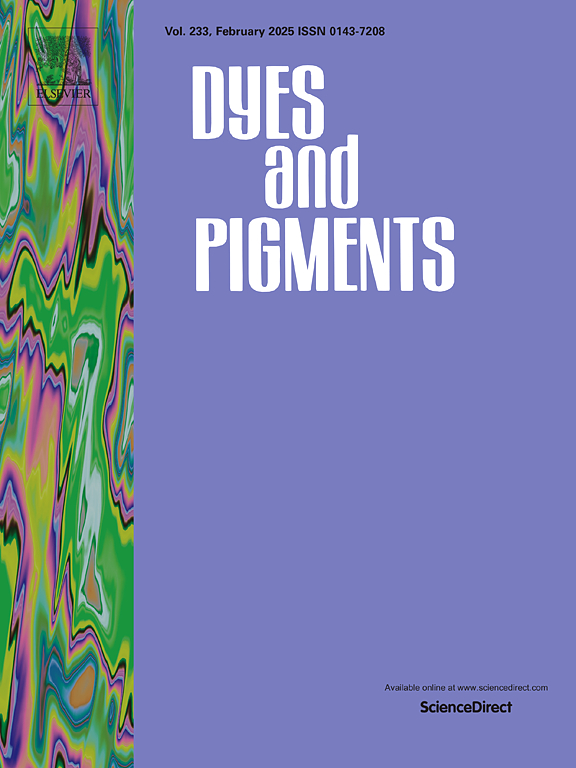磺胺酸辅助合成具有可见 pH 值响应的氮硫共掺生物质碳点,用于传感硝基呋喃类抗生素
IF 4.1
3区 工程技术
Q2 CHEMISTRY, APPLIED
引用次数: 0
摘要
抗生素的滥用对粮食安全和人类健康构成严重威胁,因此对硝基呋喃类抗生素进行快速、灵敏的检测至关重要。本研究以菜籽粕为原料,采用简单的水热法制备了具有亮蓝色荧光的碳点材料。磺胺酸不仅能提供N和S元素,还能有效破坏菜籽粕内部坚固的化学结构。N和S的巧妙掺杂使2SRM-CDs的QY达到了32.4%。2SRM-CDs的发光位点随pH值的变化而变化,因此对pH值的变化表现出有趣的视觉响应。此外,2SRM-CDs对呋喃唑酮、呋喃妥英和呋喃唑酮在浓度为1.0 ~ 330 μM、0.5 ~ 260 μM和0.5 ~ 230 μM时的检出限分别为0.354 μM、0.258 μM和0.327 μM,具有良好的灵敏度和选择性。此外,所开发的传感器可以成功地用于检测实际样品中的NFs,这在环境监测和食品分析等领域显示出潜力。本文章由计算机程序翻译,如有差异,请以英文原文为准。

Sulfanilic acid assisted-synthesis of nitrogen and sulfur co-doped biomass carbon dots with visible pH response for sensing nitrofuran antibiotics
The abuse of antibiotics posed a serious threat to food security and human health, therefore it was of vital importance for fast and sensitive sensing of nitrofuran antibiotics (NFs). In this study, carbon dots materials with bright blue fluorescence were developed by applying an easy hydrothermal method from rapeseed meal assisted by sulfanilic acid. The sulfanilic acid could not only supply N and S elements, but also effectively break the internal robust chemical structure of rapeseed meal. The skillful doping of N and S contributed to a high QY of 32.4 % for 2SRM-CDs. The luminescent sites of 2SRM-CDs changed with pH, and therefore exhibited an interesting visual response to pH variation. Besides, the 2SRM-CDs showed satisfactory sensitivities and selectivities for furazolidone, nitrofurantoin and nitrofurazone with the limits of detection of 0.354 μM, 0.258 μM and 0.327 μM, when their concentrations were 1.0–330 μM, 0.5–260 μM and 0.5–230 μM,respectively. Furthermore, the as-developed sensor could be successfully used to detect NFs in actual samples, which demonstrated potential in fields such as environmental monitoring and food analysis.
求助全文
通过发布文献求助,成功后即可免费获取论文全文。
去求助
来源期刊

Dyes and Pigments
工程技术-材料科学:纺织
CiteScore
8.20
自引率
13.30%
发文量
933
审稿时长
33 days
期刊介绍:
Dyes and Pigments covers the scientific and technical aspects of the chemistry and physics of dyes, pigments and their intermediates. Emphasis is placed on the properties of the colouring matters themselves rather than on their applications or the system in which they may be applied.
Thus the journal accepts research and review papers on the synthesis of dyes, pigments and intermediates, their physical or chemical properties, e.g. spectroscopic, surface, solution or solid state characteristics, the physical aspects of their preparation, e.g. precipitation, nucleation and growth, crystal formation, liquid crystalline characteristics, their photochemical, ecological or biological properties and the relationship between colour and chemical constitution. However, papers are considered which deal with the more fundamental aspects of colourant application and of the interactions of colourants with substrates or media.
The journal will interest a wide variety of workers in a range of disciplines whose work involves dyes, pigments and their intermediates, and provides a platform for investigators with common interests but diverse fields of activity such as cosmetics, reprographics, dye and pigment synthesis, medical research, polymers, etc.
 求助内容:
求助内容: 应助结果提醒方式:
应助结果提醒方式:


